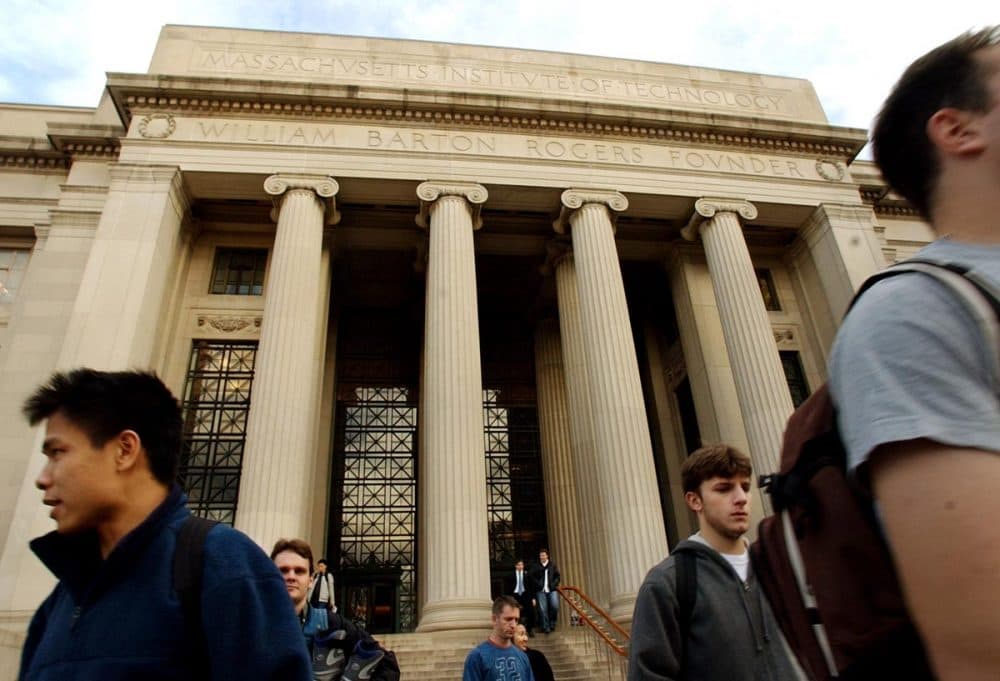Advertisement
Why The Best Low-Income Students Often Don't Apply To The Most Competitive Colleges
Resume
The best low-income students often don't apply to the most selective schools.
Former college admissions officer Sean Logan has a story about a student from Salinas, Calif., at the top of her class. Both parents were migrant farm workers. She wanted to go to Stanford University, but did not think a highly selective university would find her interesting.
"And tears start falling down her face," Logan recalled. "And she said, 'Look, I’m from a little small place. I can’t compete. How do I do this?' I said, 'I’ve been doing this a long time. You’re going to be a great applicant for a lot of schools.' Tears. Just tears. 'I wasn’t going to apply.' "
At the time, Logan worked in admissions at Williams College in western Massachusetts. He traveled the country looking for exceptional students from unusual places. He persuaded that Salinas student to apply. She got into Stanford and every school she applied to. Logan, now the director of college counseling at Phillips Andover Academy, says he saw this all the time.
“That’s not an unusual experience for me, dealing with kids who just don’t understand how good they are and what their opportunities are."
Sean Logan, former college admissions officer
"That’s not an unusual experience for me. dealing with kids who just don’t understand how good they are and what their opportunities are," he said. "And a place like Stanford for her is going to change her life. The opportunities to interact with the range of students that’s brought into Stanford. She’s going to graduate with no debt."
Here's what Logan means: Public universities used to be the most affordable, but with crunches in federal and state budgets, many are not so affordable any more. And the best-endowed private colleges are devoting more money to financial aid. But tens of thousands of the best low-income students don't apply to the hardest schools to get into and, thus, miss out on the opportunity to graduate from college with no little or no debt.
Chris Avery, a professor at Harvard University's Kennedy School of Government, is among the scholars who have identified this problem.
"Many of the highest-achieving students from the poorest families really shut the doors themselves," Avery said. "They don’t apply to any selective college anywhere."
Avery's research concludes that these students are in high schools that are hard to cover for college admissions staff: in major cities, but not in magnet schools such as the Boston Latin School; in smaller cities that have no magnet schools; and in rural areas.
One reason high-achieving students don't apply to the most selective colleges: They don’t know about those colleges.
"We are a small college in a corner of Massachusetts," said Williams College President Adam Falk. "We’re not the most obvious place for a student to go from South Central Los Angeles, from a large urban school, who may not even have heard of us."
Another reason low-income students don’t apply to the most selective colleges: They don’t realize they can afford to go.
"We’re admitting students regardless of their ability to pay, and I think that’s not the norm for most colleges and universities," Jennifer Desjarlais, the dean of admissions at Wellesley College, said. "We’re fortunate to have the resources to do that."
The large endowments of some of the most selective schools enable them to welcome low-income students.
At Williams, 1 in 7 students is a first-generation college student. Falk says the college’s $2 billion endowment allows it to pay for their education and to make sure they don’t drop out.
"We don’t lose students at Williams, and that’s a great advantage to being a small place," he said. "Well over 90 percent of our students graduate within six years."
Many students don't realize which colleges are in the best position to invest in them.
As assistant director of admissions at Wellesley, Maggie Farnsworth knows this firsthand.
"I had a student one year," she recalled, "she had taken what she thought was a full ride at her local state university, but it only covered tuition, but she didn’t read the fine print until after she had deposited, and it was way past our deadline, and she called and she goes. 'Oh, my goodness. I didn’t realize I’m now going to have to pay room and board.' And room and board these days is thousands of dollars."
Another reason certain students don't apply: They don't think they're good enough.
"I remember one of my students who is graduating from Brown University this year said to me her sophomore year at Brown, 'If I hadn’t met you and you hadn’t told me to look at this school called Brown, I would be at community college,'” said Rob Andrews, who used to work for a foundation that looked for high-achieving students in schools that typically don't send most of their students to college.
"I think [Andrews] was instrumental in making me realize that I was smart enough," said Maria Hernandez, who emigrated from Mexico to the Chicago area at age 10. She attended Waukegan High School, one of the largest in the country. She had a 4.0 grade point average, but she did not see herself at an Ivy League school.
"It was very difficult for me to understand and accept that I deserved to be at a school like Brown," Hernandez said. "I think Rob was instrumental [in] helping me realize my potential and helping me explain to my parents why coming to college was a good decision."
Hernandez says her parents told her that with a high school diploma, she would make more money than they did, and so it was time to go to work. Andrews persuaded them that college would not be a waste of time.
Andrews is now director of college counseling at Prospect Hill Academy, a charter school in Cambridge. Because he and another counselor together advise only 60 seniors, he’s able to make sure the best students do apply to the most selective schools.
"They will trust me when I say, 'No, I know your friend applied to this other school and they didn’t give you financial aid, but that school doesn’t give good financial aid,' " Andrews said. "'This school does, and it’s even better than the school you think you should be going to for who you are.' "
But that counseling often does not happen in schools where guidance counselors are overtaxed. The average American high school guidance counselor has 476 students, and most students are not college-bound.
Edith Cricien grew up in Miami, and 3,000 students attended her public high school. The counselors were overworked and did not encourage students to look beyond local colleges. But her AP European History teacher did.

"And she was very big on, 'Leave Miami. You need to be exposed to something different,' " Cricien said.
Cricien's mom is from Peru, her dad from Colombia. They live in one of the many lower-middle-class communities close to the Miami airport, where her dad repairs machines. She says her parents were unusual in letting her go.
"Because it’s not very common of Hispanic families," she said. "They usually are very close-knit and want everybody to kind of stick together and stay at home. It’s a cultural aspect of Miami in general."
Cricien says very few of the other great students she knew ever left Florida. She did. She is about to graduate from Amherst College.
Colleges adopt different strategies to find high-achieving low-income students.
"We don’t need to visit the schools that have good guidance counselors and parents who are very involved, because those students already are quite conscious of MIT," said Stu Schmill, dean of undergraduate admissions at the Massachusetts Institute of Technology.
At Wellesley, part of the strategy is to make it easy to figure out how little a student would have to pay if she attended. Wellesley has devised a simple Web calculator that lets students figure out in three minutes what their costs would be.
"The only price that they know of college education is the sticker price, and that just is not the case for the vast majority of the population," said Wellesley economics professor Phillip Levine, who devised the calculator. "About 90 percent of the population would be eligible for financial aid if they were to attend Wellesley College."
In the last decade, a California nonprofit has transformed the way colleges find low-income high-achieving students. Called QuestBridge, part of its success comes from its application, accepted by 35 of the most selective colleges.
Natalie Ornell, from Braintree, used it when she applied to Wellesley. It allowed her to write more in-depth essays than the Common Application, so she could provide context about how she grew up.
"I was able to write more about my life and my background, some of the challenges I faced growing up in a single-parent household," she said.
Amherst has 16 QuestBridge scholars in its incoming class next fall. They come from trailers, subsidized housing, rural Kentucky, tiny homes in the South Bronx. Their Scholastic Achievement Test (SAT) scores, taken in junior year, are in the high 600s.
"Think about how intelligent those kids have to be," said Dean of Admissions Tom Parker. "This is not the group that's been tutored. These are kids who probably took those SATs cold."
Low-income students represent a growing percentage of graduating high school students. So these low-income kids represent the future of America's intellectual power.
This segment aired on February 27, 2014.
